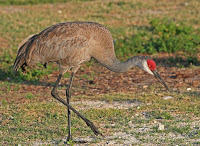SANDHILL CRANE
SANDHILL CRANE – (Antigone canadensis) – (See images below)
DESCRIPTION: The Sandhill crane is a large bird with a long neck and long legs. The plumage is grey with ochre overtones. A distinctive feature of the sandhill crane is a red forehead. The bill and legs are almost black. Both sexes are similar. There are many subspecies in different distribution areas. The bird measures around 120 cm (4 feet) long.
VOICE: https://www.xeno-canto.org/species/Antigone-canadensis
NAME: The sandhill crane owes its English name to the area (Sandhills) where it is found in the western USA. The Latin genus name ‘Antigone’ is from Greek mythology, where princess Antigone was transformed into a crane (Helm).
HABITAT: Grassland and prairie marshes.
DIET: Seeds and insects.
BREEDING/NESTING: This bird has an elaborate courtship ritual. The nest is located in thick emergent vegetation. Usually two light green eggs are laid, which are incubated by the female. Chicks are fed by both parents.
DISTRIBUTION: This crane is a North American species for the most part. Its main breeding territory is in western Canada (hence the Latin name) starting from Ontario, and parts of Alaska. It migrates to the western half of the USA and northern Mexico. Some individuals have been able to reach Hawaii (see note below on bird vagrancy). There is also a small year-round population in Florida and Cuba.
Distribution map: https://en.wikipedia.org/wiki/Sandhill_crane#/media/File:Antigone_canadensis_map.svg
ON PEI: The sandhill crane does not breed on Prince Edward Island. Sightings are rare or occasional depending on the seasons (see photos below).
CONSERVATION: The sandhill crane is not considered at risk as per the IUCN. However there are many conservation programs to preserve the bird’s habitat (see references below).
NOTES: When flying, as opposed to the Heron family, cranes keep their long necks straight. This species dates back to almost 10 million years, one of the oldest known still existing. They are social birds, and when migrating they can form very large flocks. They also fly at high altitudes during migration.
Vagrancy: In biology this means an animal going way outside its normal range. For birds, this can happen when there are storms and they get blown off course. On other times, the bird simply wanders in a different direction than usual. Here’s an article about vagrancy in birds.
SIMILAR SPECIES: The sandhill crane is slightly shorter than the Great Blue Heron.
REFERENCES: https://www.borealbirds.org/bird/sandhill-crane
https://www.audubon.org/field-guide/bird/sandhill-crane
https://www.allaboutbirds.org/guide/Sandhill_Crane/id
http://www.sccp.ca/species-habitat/sandhill-crane (British Columbia South Coast Conservation Program)
American Bird Conservancy (Sandhill Crane)
Saving Cranes.org (Sandhill Crane)
https://en.wikipedia.org/wiki/Sandhill_crane
DESCRIPTION: The Sandhill crane is a large bird with a long neck and long legs. The plumage is grey with ochre overtones. A distinctive feature of the sandhill crane is a red forehead. The bill and legs are almost black. Both sexes are similar. There are many subspecies in different distribution areas. The bird measures around 120 cm (4 feet) long.
VOICE: https://www.xeno-canto.org/species/Antigone-canadensis
NAME: The sandhill crane owes its English name to the area (Sandhills) where it is found in the western USA. The Latin genus name ‘Antigone’ is from Greek mythology, where princess Antigone was transformed into a crane (Helm).
HABITAT: Grassland and prairie marshes.
DIET: Seeds and insects.
BREEDING/NESTING: This bird has an elaborate courtship ritual. The nest is located in thick emergent vegetation. Usually two light green eggs are laid, which are incubated by the female. Chicks are fed by both parents.
DISTRIBUTION: This crane is a North American species for the most part. Its main breeding territory is in western Canada (hence the Latin name) starting from Ontario, and parts of Alaska. It migrates to the western half of the USA and northern Mexico. Some individuals have been able to reach Hawaii (see note below on bird vagrancy). There is also a small year-round population in Florida and Cuba.
Distribution map: https://en.wikipedia.org/wiki/Sandhill_crane#/media/File:Antigone_canadensis_map.svg
ON PEI: The sandhill crane does not breed on Prince Edward Island. Sightings are rare or occasional depending on the seasons (see photos below).
CONSERVATION: The sandhill crane is not considered at risk as per the IUCN. However there are many conservation programs to preserve the bird’s habitat (see references below).
NOTES: When flying, as opposed to the Heron family, cranes keep their long necks straight. This species dates back to almost 10 million years, one of the oldest known still existing. They are social birds, and when migrating they can form very large flocks. They also fly at high altitudes during migration.
Vagrancy: In biology this means an animal going way outside its normal range. For birds, this can happen when there are storms and they get blown off course. On other times, the bird simply wanders in a different direction than usual. Here’s an article about vagrancy in birds.
SIMILAR SPECIES: The sandhill crane is slightly shorter than the Great Blue Heron.
REFERENCES: https://www.borealbirds.org/bird/sandhill-crane
https://www.audubon.org/field-guide/bird/sandhill-crane
https://www.allaboutbirds.org/guide/Sandhill_Crane/id
http://www.sccp.ca/species-habitat/sandhill-crane (British Columbia South Coast Conservation Program)
American Bird Conservancy (Sandhill Crane)
Saving Cranes.org (Sandhill Crane)
https://en.wikipedia.org/wiki/Sandhill_crane
 |
| Sandhill cranes, Manjith Kainickara |
 |
| Sandhill crane, FL, Joseph C. Boone |
 |
| Sandhill cranes, PEI, Marcy Robertson |
 |
| Sandhill crane, PEI, by Joanne Dunphy |